Child Safety Guide
Tips to Keep Kids Safe at Home, School, Outdoors, & Traveling
Kids, they are masters of chaos, and they are our everything. For parents, guardians, and caregivers, keeping them safe is a daunting task and our number one priority. Whether it is an accident at home like a radiator burn or an accident at school, we share some of the most recent statistics of accidents amongst children.
Unfortunately, accidents and injuries happen, and the most recent available statistics from the Centers for Disease Control and Prevention (CDC) are sobering.
- Unintentional injuries are the leading cause of death among children and teens in the United States.
- Emergency departments treated more than 4.1 million children and teens for accidental injuries in 2020.
- More than 7,000 children and teens died from unintentional injuries in 2019.
Although perfect safety is an impossible goal, you can significantly reduce childhood injury risks by following basic child safety practices. This guide provides critical recommendations, resources, and guidelines for keeping kids of all age groups safe in different environments.
Quick Links
Childproofing Your House 101
: Safety Information for Young Children, Infants, & ToddlersWhether you are a new parent or have small children at home, one of the most important things you can do is make your home as safe and hazard-free as possible. We’ll begin with a general scan of your home to identify and remove potential child safety hazards. Then we’ll explore tips for eliminating hidden dangers from specific rooms in your home to create a sanctuary for your little ones.

Window & Door Safety
Start at the top of your home and work your way down. Securing your windows and doors should be one of the first places you start when childproofing your home.
Window and door safety to-dos:
- Move furniture that children can climb on away from windows.
- Keep windows locked and closed when not in use.
- Screens are not enough to prevent falls; install window guards for extra security.
- Keep doors to risky places, such as basements and attics, shut and locked.
- Avoid choking hazards by moving cribs, beds, and other furniture away from corded blinds.
- Or use cordless blinds to keep babies safe.
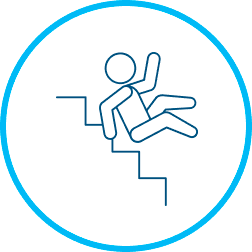
Preventing Falls at Home
Falls are the most common cause of childhood emergency room visits. In 2020 more than 1.3 million children and teens were treated in emergency departments for fall-related injuries.
As soon as your baby starts crawling, you’ll want to take the following precautions:
- Install child safety gates across the top and bottom of stairs and balconies.
- Always carefully supervise your child when they’re on or near balconies.
- Remove tripping hazards, such as loose rugs or electric cords.
- Put non-slip pads underneath all rugs.
- Install furniture corner guards on all sharp furniture corners.
Now that you’ve got your windows, doors, and furniture safely locked, anchored, and secure, let’s explore each room of your home.

Bathroom Safety
Keep your bathrooms off-limits to small children and toddlers. When paired with your ongoing supervision, these tips can help you reduce the most common dangers.
- Install toilet seat locks to prevent toddlers from drowning.
- Use non-slip flooring and bathtub mats to prevent falls.
- Keep medicines and household products in a locked cabinet.
- Install anti-scald devices on your bathtub and sink faucets.

Home Fire Injury Prevention
Fires and burns are the third leading cause of unintentional injuries to children in the United States. And in 2020, more than 71,000 children and teens were treated for fire and burn injuries.
Here are some essential tips to prevent child injuries from fire:
- Install smoke and carbon monoxide detectors on every level of your home and outside all sleeping areas. Test them monthly, and replace the batteries at least once a year.
- Create and practice a home fire escape plan.
- Keep a fire extinguisher in an accessible location, and teach family members how to use it.
- Never leave children unattended near an open flame, such as a candle, fireplace, or grill.
- Dispose of all smoking materials appropriately.

Defective Products & Recalls
The recent Peloton treadmill tragedy heightened parents’ concerns over dangerous products in their homes. While most companies are diligent about ensuring the safety of their products, there are simple steps parents can take to protect their children from unsafe products.
Most importantly, parents can check the database of all recalled products maintained by the U.S. Consumer Product Safety Commission. Parents can also use the website to register new child products, such as toys or furniture, and receive emails about future recalls.

Furniture Safety
According to a study from the Center for Injury Research and Policy at Nationwide Children’s Hospital, once every 46 minutes, a child is treated in an emergency room after furniture tips over on them.
Furniture safety to-dos:
- Use wall anchors to secure shelves, desks, dressers, and other heavy furniture.
- Mount televisions to the wall whenever possible.
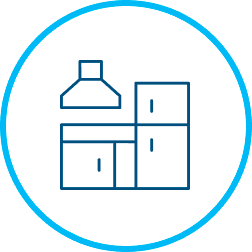
Kitchen Safety
Ideally, your kitchen would be entirely off-limits to small children and toddlers. But because it’s not always possible to keep your child safely occupied in another room while you cook dinner, these tips will help you keep your little explorer away from the danger zones.
- Install safety locks for your cabinets, drawers refrigerator, and oven.
- Keep knives and sharp objects out of children’s reach.
- Use back burners and turn pot and pan handles toward the back of the stove.
- Check your smoke detector regularly, and keep a fire extinguisher nearby and out of a child’s reach.
Communicate with your kids about home safety early and often. Use every available moment to emphasize the dangers of a hot stove (“ouch, hot”) and other kitchen hazards.
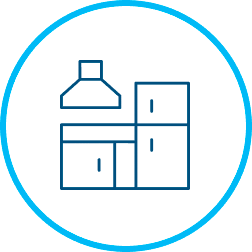
Household Products & Poisoning Prevention
Childproofing your home is vital to keeping kids safe, but it’s important to remember that even child-safe products can pose a danger if misused.
Many household items can cause accidental poisoning. Adhere to the following tips to prevent injuries:
- Small objects: Small objects such as coins, buttons, marbles, and beads can pose choking hazards for young children. Keep any small items out of reach and carefully inspect toys before giving them to young children to ensure they don’t contain small parts.
- Plastic bags: Plastic bags can cause suffocation if a child puts one over their head. Keep them out of reach.
- Cleaning products: Many cleaning products contain chemicals that can be harmful if ingested or inhaled. Keep all household cleaners, laundry pods, soaps, and hand sanitizers out of reach of children, and always read the labels before using them. Also, look for child-safe cleaning products that are nontoxic and free of harmful chemicals.
- Medications: Keep all medicines, whether over-the-counter or prescription, out of reach of children. Be sure to read all labels carefully and follow proper dosage and storage instructions. Never give a child medication that your doctor prescribed for another person.
If you suspect that a child has ingested dangerous household chemicals or medication, contact poison control immediately at 1(800) 222-1222.

Toy Safety
According to the U.S. Consumer Product Safety Commission, emergency room personnel treated an estimated 198,000 toy-related injuries in 2020. And about 40% of all toy-related injuries happened to children four years of age or younger.
You can reduce the risk of serious injury by:
- Carefully reading instructions and warning labels to confirm that the toy is age appropriate
- Reducing toxic chemicals exposure by choosing toys made from natural materials, such as cotton, wool, and untreated wood
- Being mindful of small toy parts that may pose a choking hazard for children younger than three years old
- Keeping toys stored in a safe location to prevent family members from tripping over loose toys when playtime is over.
According to the American Academy of Pediatrics, caretakers should keep soft toys away from an infant’s sleeping area to reduce the risk of may increase the risk of suffocation and strangulation.
Making School Safety a Priority
Safe and secure schools are essential to producing happy and healthy children. While various safety risks can lead to severe injuries and threaten the well-being of students, these tips can reduce the likelihood of preventable injuries and keep children safe.

Playground Safety Tips
Playgrounds provide children with a place to explore, have fun, and burn off energy. But without proper precautions and supervision, they can result in injury. According to the CPSC, children experience about 200,000 playground injuries each year.
Before letting your kids run amok on the jungle gym, carefully inspect the equipment for visible hazards. For example, check for:
- Sharp edges, open S-hooks, or any protruding nails, screws, or bolt ends
- Burning hot surfaces
- Insufficient impact surface materials to absorb a hard fall
Make sure children playing wear appropriate clothing. Avoid anything that could cause strangulation or get caught in equipment. These items include:
- Hooded sweatshirts or clothing with drawstrings
- Necklaces and other jewelry
- Backpacks
Lastly, to prevent life-altering injuries, teach children how to play safely on the playground. That means learning to take turns on the equipment and avoiding pushing, shoving, and roughhousing on the equipment. And, of course, adults should always supervise children on the playground.
Dealing with Bullying at School
Bullying is a problem that can negatively affect students’ mental health and well-being. Persistent bullying can lead to diminished academic performance and feelings of isolation, low self-esteem, and depression. In extreme cases, bullying can lead to suicide.
Parents and teachers can mitigate bullying by being aware of the signs and taking action immediately.
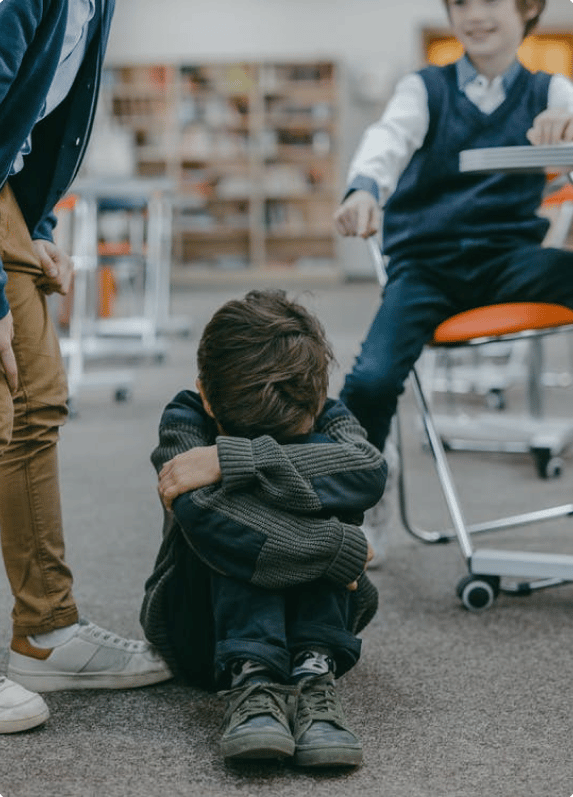
A child who is being bullied may exhibit the following warning signs:
- Withdrawal from friends or social activities
- Difficulty sleeping
- Loss of appetite
- Rashes or unexplained bruises
- Unexplained loss of belongings
- Frequent complaints of being sick
If you suspect your child is a victim of bullying, talk to them about it. You should also contact the child’s teacher or school administrators immediately.
Some ways to prevent bullying include:
- Teaching children empathy and compassion
- Encouraging children to be assertive
- Teaching children how to stand up for themselves and others
- Fostering a sense of inclusion within the school community
- Monitoring children’s social media activity
- Leading by example by modeling kindness and respect toward others
Asbestos in Schools
Asbestos is a naturally occurring mineral widely used in construction materials from the early 1940s through the 1970s. It is still present in many older schools, and prolonged exposure can lead to the development of mesothelioma, a rare but deadly cancer. Despite the risks, asbestos is still present in many schools.
Asbestos-containing materials may be in good condition and pose little risk. But if the materials get damaged or disturbed, asbestos fibers may be released into the air and inhaled by students and employees.
To prevent asbestos exposure in schools, the U.S. Environmental Protection Agency (EPA) provides these recommendations for school administrators:
- Inspect the school for asbestos-containing materials and have any damaged or deteriorating materials repaired or removed by a certified asbestos abatement contractor.
- Minimize the disturbance of asbestos-containing materials.
- Make sure that only trained and accredited individuals work with or around asbestos.
- Provide information about the location and condition of asbestos-containing materials to teachers, staff, parents, and students.
- Regularly monitor the condition of asbestos-containing materials.
If you suspect that your child has been exposed to asbestos, talk to their doctor. You should also contact an experienced attorney who specializes in mesothelioma cases.
Daycare & Preschool Safety Considerations
Choosing the right child care center for your child is one of the most important decisions you will make as a parent or caregiver. You want to keep your child comfortable while in the care of others, and you need to ensure that the center will prioritize their health, promote safety, and prevent daycare injuries.
When choosing a daycare or preschool facility, you’ll likely have a lengthy checklist of questions about their staff-to-child ratio, food nutrition options, and approach to safe sleep practices.
In addition to these concerns, make sure you get a definite “yes” to these critical questions:
- Does the state license the facility?
- Is it clean and well-maintained?
- Do they have clear security and check-in procedures?
- Has the staff received CPR and first aid training?
- Do they have comprehensive emergency preparedness plans?
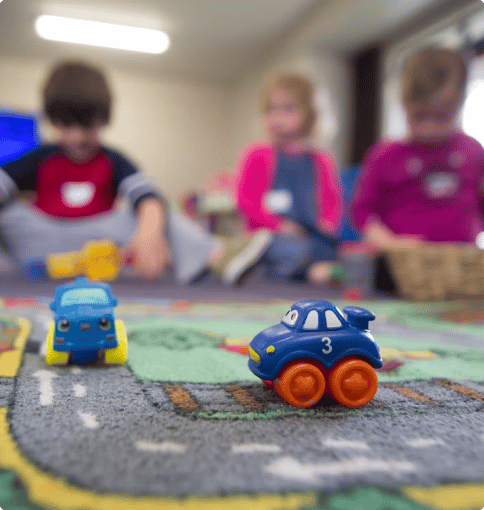
As part of your safety check, be sure to tour the facility and meet the staff before enrolling your baby or preschooler.
Child Passenger Safety
For injury prevention, child safety seats are not only the most essential item in your vehicle, but they’re arguably the most effective item in your child safety tool set.
First, let’s consider the dangers facing child passengers. According to the CDC’s 2019 data, car accidents cause more deaths and disabilities among children than other leading causes of unintentional injury.
Child Passenger Safety Facts
child passengers aged 12 and under died in motor vehicle crashes.
child passengers were injured.
Protective Benefits of Child Safety Seats
According to National Highway Traffic Safety Administration (NHTSA) data, child car seats and booster seats reduce the risk of fatalities by 71% for infants under one year old and 54% for toddlers ages one to four years.
Undoubtedly, child safety seats save thousands of lives every year. To ensure that you get the most protective benefits, you also need to make sure that you use the right car seat type and install it properly.
4 Types of Car Seats
The appropriate child safety seat type depends on your child’s age group, weight, and height.
Here’s an overview of the four main types of child car seats:
Rear-Facing Car Seats (Birth–2 years): Infants and toddlers under the age of two should always ride in a rear-facing car seat.
Forward-Facing Car Seats (2–5 years): As your child grows, they should ride in a car seat facing forward with a harness system.
Booster Seats (4–8 years): Once your child outgrows their forward-facing child car seat, they can use a booster seat until your vehicle’s adult seat belt system fits them correctly.
Seat Belts (8–12 years): Older children can safely use your vehicle’s adult seat belt system.
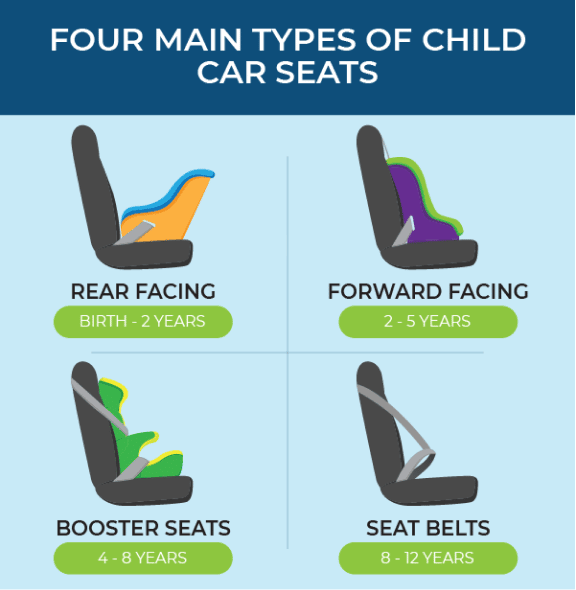
Car seats are effective only if installed properly and used correctly. To improve child passenger safety benefits, familiarize yourself with the car seat and booster seat safety guidelines from the National Highway Traffic Safety Administration (NHTSA).
Bicycle & Pedestrian Safety
As children grow and expand their physical boundaries, bicycle and pedestrian safety becomes increasingly critical — especially for those who live in urban areas. Parents and guardians can keep their children safe on the streets.
Bicycle Safety Basics
The bicycle represents a child’s first taste of independence and mobility. But along with that comes a new set of risks and hazards.
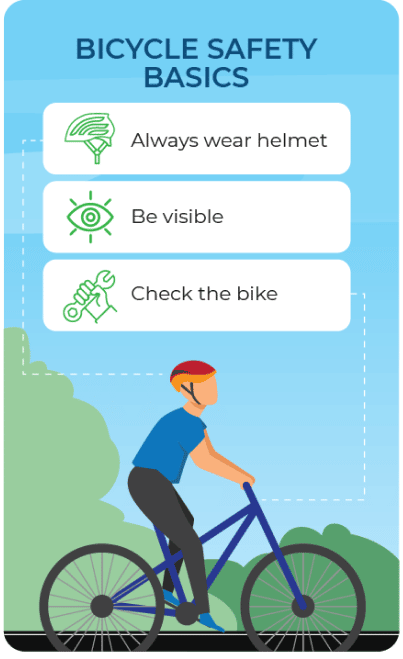
Bicycle Safety Recommendations
- Always wear a helmet.
- Children should wear a properly fitting helmet when riding a bicycle, scooter, or skateboard. Helmets can reduce the risk of serious head injury by 53%.
- Be visible.
- To improve visibility to drivers, children should wear bright colors or reflective gear when riding.
- Check the bike.
- Before each ride, check the tires for proper inflation and check that the brakes are working correctly.
Parents should always lead by example. Children are more likely to wear a helmet and follow these rules when they see their parents doing the same.
Pedestrian Safety Basics
As children become more independent, they will also spend more time walking or running around the neighborhood.
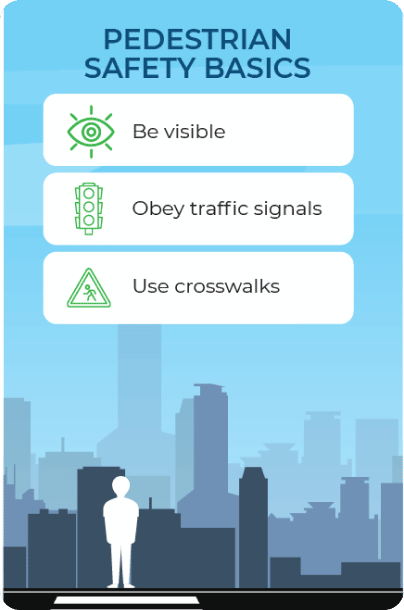
Pedestrian Safety Suggestions
- Be visible.
- To improve visibility to drivers, children should wear bright colors or reflective gear when walking or running.
- Obey traffic signals.
- Children should always look both ways before crossing the street and obey all traffic signs and signals.
- Use crosswalks.
- Parents and guardians should teach their children to use crosswalks whenever possible.
As with bicycle safety, children use their parents’ behaviors as a gauge for their own when walking along and crossing streets. Always consider the example you set when it comes to pedestrian safety.
Critical Water Safety Lessons
Water Safety Facts
- For children aged 1–4 years, drowning is the leading cause of injury and death.
- Drowning kills about 4,000 people per year.
- Drowning death rates for Native American and Black people are 2.0 and 1.5 times higher than the drowning death rates for white people.
It’s hard to reconcile the two contradictory qualities of water. On the one hand, it’s essential to life and a source of joy to those who love pools, lakes, rivers, and the ocean. But left unguarded, waters that seem tranquil can become a silent killer.
To prevent child drownings, the CDC recommends the following water safety tips for parents and guardians:
- Enroll children in swimming lessons
- Never leave children unattended
- Learn CPR and first aid
- Install pool fencing
- Make sure children wear life jackets
Emergency Phone Numbers

The following emergency phone numbers should be stored in every cell phone and posted near every home telephone:
Police: 911
Fire: 911
Poison Control: 1-800-222-1222
Local Hospital: ER or ambulance dispatch


